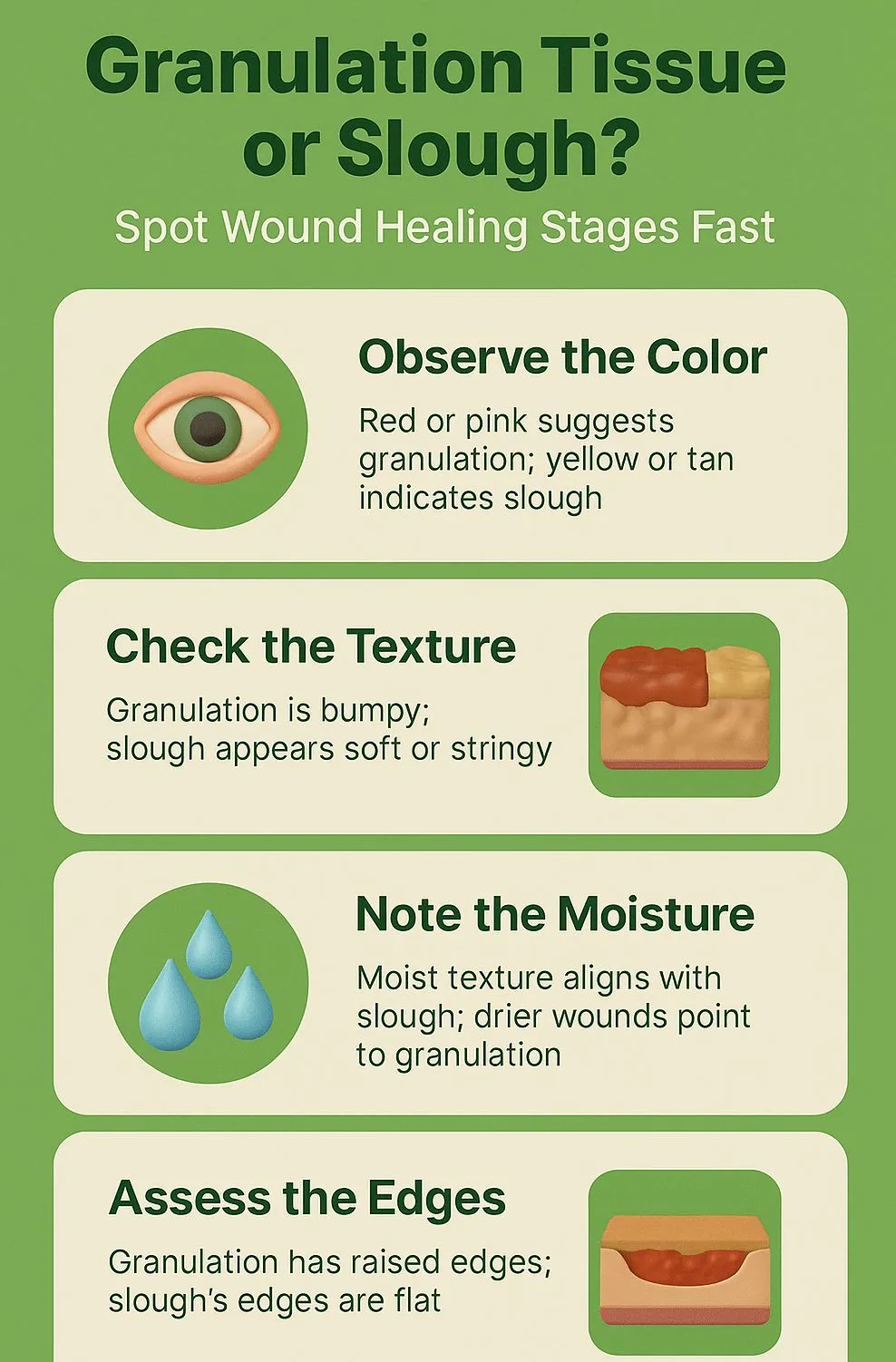In wound care, one of the quickest ways to derail healing is to confuse slough for granulation tissue. Granulation tissue is a positive sign that the wound is moving toward closure, while slough can mask infection risks and slow progress. In this guide, I’ll share proven assessment techniques, subtle clues that go beyond textbook explanations, and actionable strategies for managing a granulation tissue slough wound that consistently produce better healing outcomes in real-world care.
Top Takeaways
- Granulation vs. Slough: Granulation is moist, red or pink; slough is yellow, tan, or white.
- Act Quickly: Address slough early to prevent healing delays.
- Watch Closely: Small changes in color or texture can signal trouble.
- Select the Right Dressing: Match dressing type to the wound’s moisture and healing needs.
Recognizing Granulation Tissue and Slough
Correct identification can directly influence recovery speed and overall success.
- Granulation tissue appears moist, red or pink, and slightly granular due to new capillary growth—indicating healthy wound repair.
- Slough is a moist, yellow, tan, or white layer with a stringy or sticky texture. Made up of dead cells and debris, it may require removal to allow healing to continue.
Effective wound care includes:
- Routine wound inspection
- Monitoring color, texture, and moisture changes
- Adjusting treatment promptly based on findings
“From years in wound care, I’ve seen how a faint shift from vibrant red granulation to pale yellow slough can completely change the direction—and speed—of healing.”
Case Study & Real-World Examples: Practical Lessons
Case Study – Restoring Momentum in a Pressure Ulcer
- Long-term care patient presented with healthy granulation tissue
- Small yellow-tan patch appeared on wound edge
- Recognized as early slough based on clinical experience
- Actions taken:
- Targeted cleansing
- Dressing change for optimal moisture control
- Staff training to spot subtle changes early
- Outcome: Slough resolved within 10 days, accelerating healing. Delaying action would have added weeks to recovery.
Real-World Observation – Color as the First Indicator
- Healthy granulation = bright pink
- Early slough = dull, opaque yellow
- Changes can occur within 24–48 hours
- Early detection prevents prolonged healing phases
Research Alignment
- Journal of Wound Care (2021): Early slough removal reduced chronic wound healing times by 30% or more—consistent with clinical results.
Supporting Statistics & Field Insights
Field Perspective: These statistics reflect real patients. Early detection and treatment of slough can shorten recovery times, reduce complications, and improve patient quality of life.
Final Thought & Opinion
- Key Point: Distinguishing granulation tissue from slough early is critical for optimal healing.
- Impact: Delays can lead to longer treatment, higher costs, and worse outcomes.
- First-Hand Insight: Minor visual changes can be major red flags.
- Bottom Line: The best results come from blending established protocols with keen clinical observation and decisive action.
Next Steps
- Inspect wounds daily for color, texture, or moisture changes
- Document progress with photos or written notes
- Act immediately when slough is detected
- Select appropriate dressings to meet wound needs
- Schedule regular check-ins with a wound care specialist
Educate caregivers on spotting and responding to slough early
Frequently Asked Questions
What are the key differences between granulation tissue and slough?
Granulation tissue is healthy, moist, and red or pink with a slightly bumpy texture from new capillaries, indicating active healing. Slough is yellow, tan, or white, stringy or sticky, and made of dead cells and debris, which can slow recovery.
Why is it important to spot slough quickly?
Early identification allows for timely intervention—such as cleansing, debridement, or dressing changes—preventing healing delays, lowering infection risk, and supporting faster recovery.
Can granulation tissue and slough exist in the same wound?
Yes. A wound can show healthy granulation tissue in some areas and slough in others. The goal is to remove slough without damaging the healthy tissue.
How can I tell if a color change signals early slough?
Watch for a subtle shift from vibrant red or pink granulation to a dull, opaque yellow. These early changes may occur within 24–48 hours and should prompt reassessment.
What’s the best way to treat slough without harming granulation tissue?
Use targeted wound cleansing, moisture-appropriate dressings, and, if needed, gentle debridement under the guidance of a wound care specialist. Protect surrounding healthy tissue during treatment.
When learning how to distinguish between healing stages in granulation tissue or slough? spot wound healing stages fast, it’s important to understand that a clean environment can directly influence recovery outcomes. Contaminants in the air can increase the risk of infection, slowing the healing process. Services like Air Duct Cleaning in Navarre, FL help remove dust, allergens, and bacteria from your home’s ventilation system, while regular system upkeep with HVAC Tune-Up Miami Beach FL ensures optimal airflow and indoor air quality. Using reliable filtration products such as the 14x36x1 Pleated Furnace Filters, the 20x24x1 MERV 8 Pleated HVAC AC Furnace Air Filters 6-Pack, and the 14x36x1 Air Filter on eBay further supports a healthier environment. By combining meticulous wound observation with environmental cleanliness, you can more effectively spot healing stages and reduce the risk of complications.
